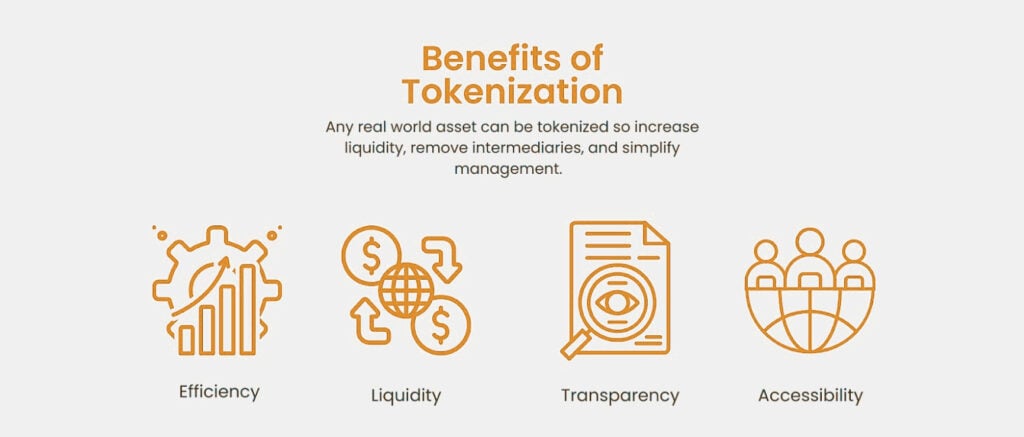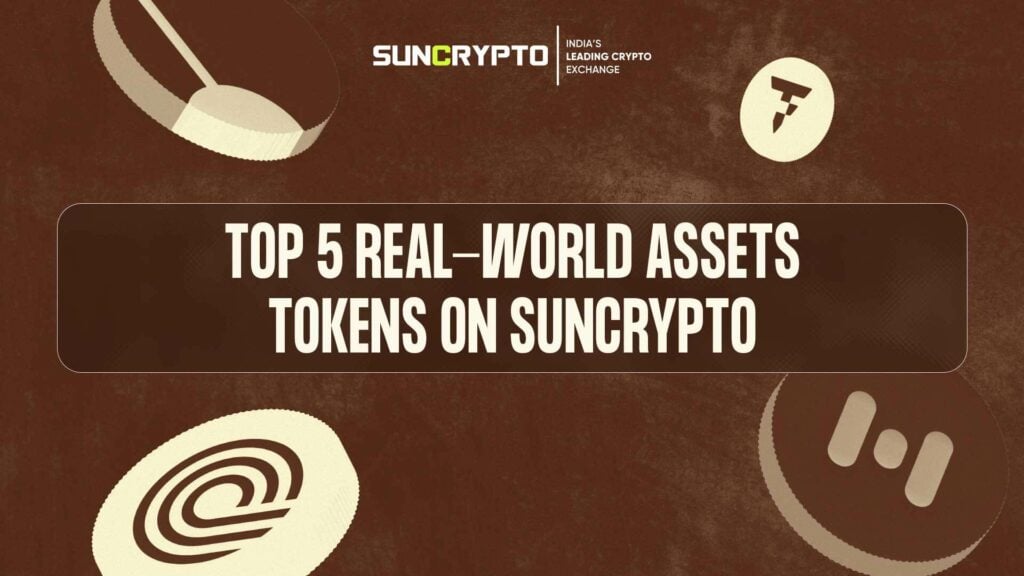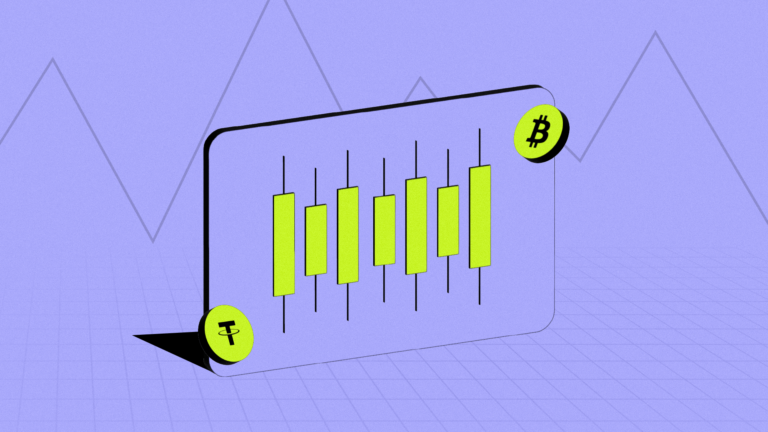In the growing landscape of crypto and blockchain technology, real-world assets (RWAs) are becoming significantly popular. These RWAs have an estimated combined asset value of more than $300 trillion, and they also provide prospects for yield generation in DeFi. Furthermore, RWAs are tied to investments with real-world value, making them an excellent method to use blockchain technology to generate revenue.
To that end, this piece of writing will look at what distinguishes RWAs from other digital assets and highlight some of the most water-shading RWA projects listed on the SunCrypto app.
What are Real-World Assets (RWAs)?
Real-world assets, or RWAs, are any assets—physical, digital, or data-based—whose value stems from their presence outside of the blockchain. By tokenizing RWAs, you are essentially creating a digital twin on the blockchain.

Tokenization offers improved transparency, liquidity, and access to real-world assets. Furthermore, by fractionalizing assets, multiple persons can own portions of high-value assets. This democratization increases engagement, empowers smaller investors, and broadens wealth distribution, altering the asset ownership and investment environment.
Meanwhile, RWAs in crypto are classified into two types: fungible and non-fungible. Fungible assets are interchangeable and divisible, which means that you may swap one unit for another of the same items without losing value. Tokenized commodities like gold or oil, as well as digital tokens linked to fiat currencies or other assets, are some examples of fungible assets.
Non-fungible assets are distinct and indivisible. Each unit of the asset has unique qualities and values. One example is non-fungible tokens (NFTs), which are digital tokens that represent ownership rights to a certain physical or digital item, such as art, music, or collectibles.
How Real-World Assets Works in Crypto?
Before we get into RWA’s utility in DeFi, let’s have a look at how it works. Specifically, how can we confirm that RWAs are genuine tokens of the real-world assets they represent? The entire process can be divided into three stages: off-chain formalization, information bridging, and RWA protocol demand and supply.
▪️ Off-Chain Formalization: Before a real-world item can be added to a digital ledger, its value, ownership, and legal standing must be established in the physical world. When estimating the value of an RWA, criteria such as market price, performance history, and asset condition are considered. The asset must also have undisputed legal possession, as evidenced by deeds or invoices.
▪️ Information Bridging: In this phase, we will go through the tokenization process, which converts the asset’s information into a digital token. The token’s metadata includes information on the asset’s value and rightful ownership. Because of the blockchain’s transparency, anyone may check the token’s legitimacy using the information.
When dealing with assets that are subject to regulation or categorized as securities, the use of regulatory technologies is critical. These may include hiring licensed security token issuers, following crypto-specific KYC (Know Your Customer) and KYB (Know Your Business) criteria, and utilizing cleared security token exchanges.
▪️ RWA Protocol Demand & Supply: The next stage, which is all about demand and supply, involves DeFi protocols that focus on RWAs. They serve two objectives. First, they assist in the creation of new RWAs, hence increasing the availability of these digital assets. They also strive to entice investors to buy and trade these assets.
Through this three-phase method, RWAs are transformed from abstract concepts to tangible, functioning, and vital components of the DeFi ecosystem, conveying the weight and trust of real-world valuation and legal frameworks into the decentralized digital realm.
Benefits of Real-World Assets in Crypto & Blockchain Industry
Tokenization of Real World Assets (RWAs) offers various compelling advantages that will transform investing methods and the crypto finance ecosystem.

▪️ Liquidity Boost: Tokenizing assets like real estate improves liquidity by converting previously illiquid and slow-moving assets into tokens. These tokens enable a larger group of investors to interact with the underlying asset.
▪️ Fractional Ownership: It is one of the most intriguing applications of RWA. Breaking down assets like real estate into tokens reduces the barrier to entry for ordinary people. As a result, a group of investors can pool their cash to collectively own the property represented by the tokens.
▪️ Openness: The blockchain’s transparent ledger ensures that every transaction and ownership data of an RWA is documented and publicly verifiable.
▪️ Diversity: The flow of tokenized assets over DeFi channels opens up new markets and financial instruments. This not only provides new options for existing investors but also attracts new participants, thereby improving the overall stability and growth potential of the financial ecosystem.
Top 5 RWA Tokens Listed on SunCrypto
🔸Ondo (ONDO)
| Price | Market Cap | Growth % (365D) |
| ₹49.56 | ₹68.87 Billion | 274% |
ONDO is the native token of Ondo Finance, a Coinbase-backed securities tokenization venture that claims to have more liquidity than traditional markets. It is also the native token of Flux Finance, a lending protocol that rewards DeFi natives with returns in exchange for lending their stablecoins to eligible investors who use the stablecoins to gain exposure to Ondo’s tokenized assets.
🔸HiFi Finance (HIFI)
| Price | Market Cap | Growth % (365D) |
| ₹69.96 | ₹8.24 Billion | 126% |
Hifi is a decentralized lending protocol on the Ethereum blockchain that allows for the lending and borrowing of cryptocurrencies at predetermined interest rates. This approach ensures lenders of their potential earnings before locking their assets into the protocol, and it allows borrowers to anticipate their payment amounts before acquiring the debt.
Furthermore, Hifi broadens options for traditional financial institutions and DeFi users by allowing borrowing against tokenized real-world assets such as stocks, real estate, and bonds.
🔸Pendle (PENDLE)
| Price | Market Cap | Growth % (365D) |
| ₹245.01 | ₹58.66 Billion | 1,084% |
Pendle is a decentralized finance (DeFi) protocol that runs on the Ethereum blockchain. Its goal is to provide users with a simple and user-friendly platform for engaging in activities like trading, yield farming, and providing liquidity for tokenized yield assets.
What distinguishes Pendle is its unique functionality that allows users to trade and set prices for tokenized yields. This functionality improves accessibility and transparency in the larger market.
🔸TokenFi (TOKEN)
| Price | Market Cap | Growth % (365D) |
| ₹6.37 | ₹6.36 Billion | 156,580% |
TokenFi is a user-friendly platform dedicated to crypto and asset tokenization, allowing users to tokenize real-world assets (RWA) and create crypto tokens without requiring technical experience or a large financial investment. It is an essential component of the Floki ecosystem, originally designed to disperse TOKEN crypto rewards among the Floki community.
TokenFi uses TOKEN coins to incentivize customers who stake FLOKI coins. TokenFi currently has one fully operating function: the Token Launcher, which allows users to easily produce tokens similar to FLOKI without the need for coding. Furthermore, TokenFi is currently developing other DeFi solutions.
🔸Avalanche (AVAX)
| Price | Market Cap | Growth % (365D) |
| ₹3,924.79 | ₹1.48 Trillion | 226% |
Avalanche is a layer one blockchain that serves as a foundation for both decentralized applications and custom blockchain networks. It is one of Ethereum’s competitors, hoping to dethrone Ethereum as the most popular blockchain for smart contracts.
The Avalanche network is made up of three separate blockchains: X-Chain, C-Chain, and P-Chain. Each chain serves a specific purpose, which differs significantly from Bitcoin and Ethereum’s model, which requires all nodes to validate all transactions. Avalanche blockchains even utilize multiple consensus mechanisms depending on their use case.
Conclusion
Real-world assets (RWAs) are bringing new energy to the asset landscape by bridging the gap between traditional and technological domains. RWAs have limitless potential because they can tokenize almost everything, including artwork, real estate, and carbon credits, as well as financial instruments such as bonds and stock.
Implementing RWAs presents a number of problems, including valuation and auditing, custody and security, governance, trust, and concerns about interoperability and scalability. Overcoming these obstacles requires extensive collaboration among all parties, including asset creators, token issuers, service providers, regulatory authorities, and traders.
To learn more about Real-World Assets, go check out SunCrypto Academy.
Disclaimer: Crypto products and NFTs are unregulated and can be highly risky. There may be no regulatory recourse for any loss from such transactions. All content provided is for informational purposes only, and shall not be relied upon as financial/investment advice. Opinions shared, if any, are only shared for information and education purposes. Although the best efforts have been made to ensure all information is accurate and up to date, occasionally unintended errors or misprints may occur. We recommend you do your own research or consult an expert before making any investment decision. You may write to us at [email protected].






Very useful information..